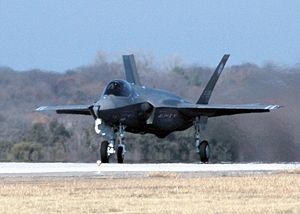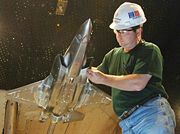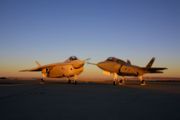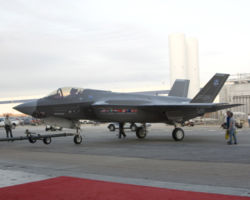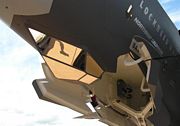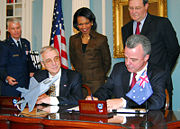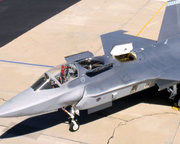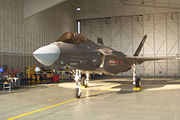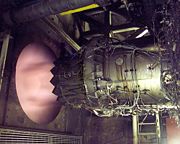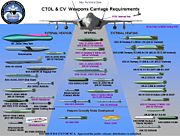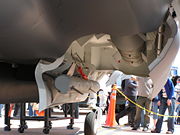F-35 Lightning II
2008/9 Schools Wikipedia Selection. Related subjects: Air & Sea transport; Military History and War
| F-35 Lightning II | |
|---|---|
|
The F-35 Lightning II takes off for its first flight at Naval Air Station Fort Worth Joint Reserve Base on 15 December 2006. |
|
| Type | Multirole fighter |
| Manufacturers | Lockheed Martin Aeronautics Northrop Grumman BAE Systems |
| Maiden flight | 15 December 2006 |
| Introduction | 2011 (scheduled) |
| Status | Under development / pre-production |
| Primary users | United States Air Force United States Navy United States Marine Corps Royal Air Force/Royal Navy |
| Produced | 2003-present |
| Unit cost | US$200 million (flyaway cost based on producing 6 aircraft in 2008) |
| Developed from | Lockheed Martin X-35 |
The F-35 Lightning II is a single-seat, single-engine, stealth-capable military strike fighter, a multi-role aircraft that can perform close air support, tactical bombing, and air-to-air combat. The F-35 is descended from the X-35 of the Joint Strike Fighter (JSF) program. Its development is being principally funded by the United States with the United Kingdom and other partner governments providing additional funding. It is being designed and built by an aerospace industry team led by Lockheed Martin with Northrop Grumman and BAE Systems as major partners. Demonstrator aircraft flew in 2000; a production model first took flight on 15 December 2006. The United States Air Force plans to acquire 1,763 aircraft.
Development
JSF Program history
Requirement
The JSF program was created to replace various aircraft while keeping development, production, and operating costs down. This was pursued by building three variants of one aircraft, sharing 80% of their parts:
- F-35A, conventional takeoff and landing ( CTOL) variant.
- F-35B, short-takeoff and vertical-landing ( STOVL) variant.
- F-35C, carrier-based (CV) variant.
The F-35 is being designed to be the world's premier strike aircraft through 2040. It is intended that its air-to-air capability will be second only to the F-22 Raptor. Specifically the F-35’s requirements are that it be: four times more effective than legacy fighters in air-to-air combat, eight times more effective in air-to-ground battle combat, and three times more effective in reconnaissance and suppression of air defenses. These capabilities are to be achieved while still having significantly better range and a smaller logistical footprint than legacy aircraft.
Origins and X-32 vs. X-35
The Joint Strike Fighter evolved out of several requirements for a common fighter to replace existing types. The actual JSF development contract was signed on 16 November 1996.
The contract for System Development and Demonstration (SDD) was awarded on 26 October 2001 to Lockheed Martin, whose X-35 beat the Boeing X-32. DoD officials and British Minister of Defence Procurement Lord Bach, said the X-35 consistently outperformed the X-32, although both met or exceeded requirements. The designation of the fighter as "F-35" came as a surprise to Lockheed, which had been referring to the aircraft in-house by the designation "F-24."
Naming
On 7 July 2006, the U.S. Air Force officially announced the name of the F-35: Lightning II, in honour of Lockheed's World War II-era twin-prop P-38 Lightning and the Cold War-era jet, the English Electric Lightning. English Electric's aircraft division was incorporated into BAC, a predecessor of F-35 partner BAE Systems. Other names previously listed as contenders were Kestrel, Phoenix, Piasa, Black Mamba and Spitfire II. Lightning II was also an early company name for the aircraft that became the F-22 Raptor.
Design
The F-35 appears to be a smaller, slightly more conventional, one-engine sibling of the sleeker, two-engine F-22 Raptor, and indeed, drew elements from it. The exhaust duct design was inspired by the General Dynamics Model 200, a 1972 VTOL aircraft designed for the Sea Control Ship.
Lockheed teamed with the Yakovlev Design Bureau in the 1990s, which has led to some speculation about ties with the quite different Yakovlev Yak-141 "Freestyle".
Stealth technology makes the aircraft hard to detect as it approaches short-range tracking radar.
Some improvements over current-generation fighter aircraft are:
- Durable, low-maintenance stealth technology;
- Integrated avionics and sensor fusion that combine information from off- and onboard sensors to increase the pilot's situational awareness and improve identification and weapon delivery, and to relay information quickly to other command and control (C2) nodes;
- High speed data networking including IEEE- 1394b and Fibre Channel.
- Low life-cycle costs.
Cockpit
The F-35 will feature a cockpit speech-recognition system ( Direct Voice Input), improving the pilot's ability to operate the aircraft over the current-generation. The F-35 will be the first U.S. operational fixed-wing aircraft to use this system, although similar systems have been used in AV-8B and trialled in previous U.S. jets, particularly the F-16 VISTA. The system is integrated by Adacel Systems Inc with the speech recognition module supplied by SRI International
Although helmet-mounted displays have already been integrated into some fourth-generation fighters such as the Swedish JAS 39 Gripen, the F-35 will be the first in which helmet-mounted displays replace a head-up display altogether, also trialled in F-16 VISTA.
Sensors
The main sensor on board the F-35 is its AN/APG-81 AESA-radar, designed by Northrop Grumman Electronic Systems. It is augmented by the Electro-Optical Targeting System (EOTS) mounted under the nose of the aircraft, designed by Lockheed Martin and BAE. Further electro-optical sensors are distributed over the aircraft as part of the AN/AAS-37 system which acts as missile warning system and can aid in navigation and night operations.
Thrust-to-weight ratio
The F-35B variant was in danger of missing performance requirements because it weighed too much — reportedly, by 2,200 pounds (1,000 kg) or 8 percent. In response, Lockheed Martin added engine thrust and shed more than a ton by thinning the aircraft's skin; shrinking the weapons bay and vertical tails; rerouting some thrust from the roll-post outlets to the main nozzle; and redesigning the wing-mate joint, portions of the electrical system, and the portion of the aircraft immediately behind the cockpit. Weighing in at up to 60,000 lb the F-35 will be the heaviest aircraft of any type ever to fly with only one engine.
Manufacturing responsibilities
Lockheed Martin Aeronautics is the prime contractor and performs aircraft final assembly, overall system integration, mission system, and provides forward fuselage, wings and flight controls system. Northrop Grumman provides Active Electronically Scanned Array (AESA) radar, centre fuselage, weapons bay, and arrestor gear. BAE Systems provides Aft fuselage and empennages, horizontal and vertical tails, crew life support and escape systems, Electronic warfare systems, fuel system, and Flight Control Software (FCS1). Alenia will perform final assembly for Italy and, according to an Alenia executive, assembly of all European aircraft with the exception of the UK's.
Operational history
Testing
On 19 February 2006, the first F-35A (USAF version) was rolled out in Fort Worth, Texas. The aircraft underwent extensive ground testing at Naval Air Station Fort Worth Joint Reserve Base in fall 2006. On 15 September 2006 the first engine run of the F135 afterburning turbofan was conducted in an airframe, with the tests completed on 18 September after a static run with full afterburner. The engine runs were the first time that the F-35 was completely functional on its own power systems. On 15 December 2006, the F-35 completed its maiden flight.
On May 3, 2007, an electrical problem consisting of electrical arcing inside a hydraulic control box forced the aircraft to make an emergency landing. It was grounded until December 7th, when Test Pilot Jon Beesley flew a 55 minute test flight.
A unique feature of the test program is the use of the so-called Lockheed CATBird avionic testbed, a highly modified Boeing 737-330, inside of which are racks holding all of F-35's avionics, as well as a complete F-35 cockpit.
International participation
While the United States is the primary customer and financial backer, the United Kingdom, Italy, the Netherlands, Canada, Norway, Denmark, Australia and Turkey have contributed US$4.375 billion toward the development costs of the program. Total development costs are estimated at more than US$40 billion (underwritten largely by the United States), while the purchase of an estimated 2,400 planes is expected to cost an additional US$200 billion. The nine major partner nations plan to acquire over 3,100 F-35s through 2035, making the F-35 one of the most numerous jet fighters.
There are three levels of international participation. The levels generally reflect the financial stake in the program, the amount of technology transfer and subcontracts open for bid by national companies, and the order in which countries can obtain production aircraft. The United Kingdom is the sole "Level 1" partner, contributing US$2.5 billion, about 10% of the development costs under the 1995 Memorandum of Understanding that brought the UK into the project. Level 2 partners are Italy, which is contributing US$1 billion; and the Netherlands, US$800 million. Level 3 partners are Canada, US$440 million; Turkey, US$175 million; Australia, US$144 million; Norway, US$122 million; and Denmark, US$110 million. Israel and Singapore have joined as Security Cooperative Participants.
Some of the partner countries have wavered in their public commitment to the JSF program, hinting or warning that unless they receive more subcontracts or technology transfer, they will forsake JSF for the Eurofighter Typhoon, Saab Gripen, Dassault Rafale or simply upgrade their existing aircraft. Norway has several times threatened to put their support on hold unless substantial guarantees for an increased industrial share is provided. Despite this Norway has signed all the Memoranda of Understanding, including the latest one detailing the future production phase of the JSF program. They have, however, indicated that they will increase and strengthen their cooperation with both competitors of the JSF, the Typhoon and the Gripen.
United Kingdom
The United Kingdom plans to acquire 138 F-35s for its Royal Air Force and the Royal Navy.
The UK became increasingly frustrated by a lack of US commitment to grant access to the technology that would allow the UK to maintain and upgrade its F-35s without US involvement. This is understood to relate mainly to the software for the aircraft. For five years, British officials sought an ITAR waiver to secure greater technology transfer. This request, which has the blessing of the Bush administration, was repeatedly blocked by US Representative Henry Hyde, who says that the UK needs to tighten its laws protecting against the unauthorized transfer of the most advanced US technology to third parties.
BAE Systems CEO Mike Turner complained that the US had denied his company access to the aircraft's source code. On 21 December 2005, an article in the Glasgow Herald quoted the chairman of the House of Commons Defence Select Committee as saying "the UK might have to consider whether to continue in the programme" if no access were granted. Lord Drayson, Minister for Defence Procurement, took a firmer stance during a March 2006 visit to Washington: "We do expect the software technology transfer to take place. But if it does not take place we will not be able to purchase these aircraft," and he said there was a 'Plan B' if the deal fell through. This may have been the development of a navalized Typhoon.
On 27 May 2006, President George W. Bush and Prime Minister Tony Blair announced that "Both governments agree that the UK will have the ability to successfully operate, upgrade, employ, and maintain the Joint Strike Fighter such that the UK retains operational sovereignty over the aircraft." Despite this, concerns were still expressed about the lack of technology transfer as late as December 2006. Nevertheless, on 12 December 2006, Lord Drayson signed an agreement which met the UK's demands for further participation, i.e., access to software source codes and operational sovereignty. The agreement allows "an unbroken British chain of command" for operation of the aircraft. Drayson said Britain would "not be required to have a US citizen in our own operational chain of command". Drayson also said, however, that Britain is still considering an unspecified "Plan B" alternative to buying the Joint Strike Fighter.
On 25 July 2007, the Ministry of Defence confirmed that they have placed orders for the two new aircraft carriers of the Queen Elizabeth Class, that will allow the purchase of the F-35B variant.
Italy
Italy plans to acquire 109 F-35As for the Italian Air Force, and 22 F-35Bs for the Marina Militare (Italian Navy) to be used on the STOVL aircraft carrier Cavour.
Netherlands
The Netherlands has plans to acquire 85 F-35As for the Royal Netherlands Air Force. The aircraft will replace an aging fleet of Lockheed Martin F-16AM. The Dutch government expects the costs to be €5.5 billion for the initial purchase and €9.1 billion for 30 years of service. On 19 November 2007, in the Dutch Parliament, the Secretary of Defence was questioned about the JSF delay, technical problems and rising costs.
Australia
In May 2005, the Australian government announced that it would delay its planned 2006 decision on buying the JSF to 2008, and thus past the term of the government of the day. Australia, like the UK, has insisted it must have access to all software needed to modify and repair aircraft. Analysis conducted by the Royal Australian Air Force has determined that the F-35 "is the most suitable aircraft for Australia's needs".
There has been debate in Australia over whether the F-35 is the most suitable aircraft for the RAAF. Some media reports, lobby groups and politicians have raised doubts that the aircraft will be ready in time to replace the RAAF's aging fleet of General Dynamics F-111 strike aircraft and F/A-18 Hornet fighters. Some critics say the more expensive F-22 or the Eurofighter may be better choices, both offering better range, dogfighting capability, and supercruise at a cost that may not be much more than the F-35 -- claims that as of July 2006 are being examined in a parliamentary inquiry.
In a statement released in early August 2006, then-Australian Defence Minister Dr. Brendan Nelson revealed that while the F-35 still had governmental support, Australia is starting to investigate other possible aircraft should the F-35 prove to be unfeasible. In October 2006 the deputy chief of the Air Force, Air Vice Marshal John Blackburn, publicly stated that the RAAF had ruled out the purchase of interim strike aircraft to cover any delays to the F-35 program and believed that the F-35 was suitable. However, on 6 March 2007, Dr. Nelson announced the Australian Government would purchase 24 F/A-18F Super Hornets from Boeing to fill the gap left by the retiring F-111 strike aircraft at a cost of potentially AU$6 billion. Nonetheless, Dr. Nelson continued to endorse Australia's purchase of the F-35. Speaking on Australian television in March 2007, Dr. Nelson stated that 5% of the capability of the F-35 is classified, claiming that, "that's the five percent that really counts."
On 13 December 2006, Minister Nelson signed the JSF Production, Sustainment and Follow-on Development Memorandum of Understanding. This agreement provides the cooperative framework for the acquisition and support of the JSF over its life. Australia is expected to purchase 100 F-35As at a cost of approximately AU$16 billion.
Turkey
On 12 July 2002, Turkey became the seventh international partner in the JSF Project, joining the United Kingdom, Italy, the Netherlands, Canada, Denmark and Norway. On 25 January 2007, Turkey signed a memorandum of understanding (MoU) for involvement in F-35 production. Turkey is expected to order 100 F-35A "CTOL/Air Force versions" at a reported cost of $11 billion. It is reported that the aircraft will be produced under license in Turkey by Turkish Aerospace Industries (TAI).
Turkish Production of the F-35
A Letter of Intent (LOI) was signed between TAI and Northrop Grumman ISS (NGISS) International on 6 February 2007. With the LOI, TAI becomes the second source for the F-35 Lightning II center fuselage during the JSF Signing. The number of centre fuselages to be produced by TAI will be determined depending on the number of F-35s Turkey will procure and the number of F-35s to be produced worldwide. The LOI represents a potential value in excess of $3 billion.
TAI of Turkey is one of the only two International Suppliers to Northrop Grumman Corporation (the other being Denmark). On 10 December, 2007 the Turkish Aerospace Industries, Inc. (TAI) was authorized by Northrop Grumman Corporation to commence fabricating subassemblies for the first two F-35 production aircraft. The subassemblies – composite components and aircraft access doors – will be used in the F-35 centre fuselage, a major section of the aircraft being produced by Northrop Grumman, a principal member of the Lockheed Martin-led F-35 global industry team.
In February 2007, Northrop Grumman also signed a letter of intent with TAI to also make it a second source for producing F-35 centre fuselages. Under that agreement, TAI will produce a minimum of 400 center fuselages starting during LRIP-2. Northrop Grumman currently produces all F-35 centre fuselages at its F-35 assembly facility in Palmdale, Calif.
It is also anticipated that TAI after 2013 will also produce 100% of the F-35 under licence from Lockheed Martin Corporation, as was also the case with the F-16 Fighting Falcon program Peace Onyx I and II.
Turkey also intends to incorporate in the distant future several Turkish designed and manufactured electronic systems into the F-35 platform.
Canada
The Canadian Department of National Defence (DND) is looking to replace its aging fleet of CF-18 Hornets by the 2020 time frame with much interest placed on the F-35. DND officials have stated the estimate for producing 80 units would cost $3.8 billion, though this figure does not include training, sustainment, and any follow on costs. Canada has until 2012 to decide on purchasing the F-35, though they have already invested $150 million in the JSF program.
Israel
In 2003, Israel signed a letter of agreement, worth almost $20 million, to formally join the system development and demonstration (SDD) effort for the F-35 as a "security cooperation participant" (SCP). The Israeli Air Force (IAF) stated in 2006 that the F-35 is a key part of IAF's recapitalization plans, and that Israel intends to buy over 100 F-35A fighters at an estimated cost of over $5 billion to replace their F-16s over time. Israel was reinstated as a partner in the development of the F-35 on 31 July 2006, after Israeli participation was put on hold following the Chinese arms deal crisis.
On 3 September 2007 IDF Chief of General Staff Lt.-Gen. Gabi Ashkenazi announced the purchase a squadron of F-35s which Israel will begin receiving in 2014. However, U.S. defense officials later agreed to allow Israel to receive the fighters as early as 2012. The price of each F-35 is expected to reach $50 million-$60m.
India
The F-35 is also a potential offer to the Indian Air Force as of July 2007. This has been interpreted as part of a tactic to sell the F-16 as a multi-role fighters to the IAF. India is not an official participant in the F-35 program.
Variants
The F-35 is planned to be built in three different versions to suit the needs of its various users.
F-35A
The F-35A, the conventional takeoff and landing ( CTOL) variant intended for the US Air Force and other air forces. It is the smallest, lightest F-35 version and is the only variant equipped with an internal gun, the GAU-12/U. This 25 mm cannon, a development of the 20 mm M61 Vulcan carried by USAF fighters since the F-104 Starfighter, is also carried by the USMC's AV-8B Harrier II.
The F-35A not only matches the F-16 in maneuverability, instantaneous and sustained high-g performance, but also outperforms it in stealth, payload, range on internal fuel, avionics, operational effectiveness, supportability and survivability. It also has an internal laser designator and infra-red sensors.
It is primarily intended to replace the USAF's F-16 Fighting Falcons, beginning in 2013, and replace the A-10 Thunderbolt II starting in 2028.
F-35B
The F-35B is the short takeoff and vertical landing ( STOVL) variant aircraft. The F-35B is similar in size to the Air Force F-35A, trading fuel volume for vertical flight systems. Like the AV-8 Harrier II, guns will be carried in a ventral pod. Vertical flight is by far the riskiest, and in the end, a decisive factor in design.
The F-35's main power plant is derived from Pratt & Whitney's F119 or GE Rolls Royce fighter team's F136, with the STOVL variant of the latter incorporating a Rolls-Royce Lift Fan module. Instead of lift engines, or rotating nozzles on the engine fan and exhaust like the Pegasus-powered Harrier, the F-35B uses a vectoring cruise nozzle in the tail, i.e. the rear exhaust turns to deflect thrust down, and an innovative shaft-driven Lift Fan, patented by Lockheed Martin and developed by Rolls-Royce. Somewhat like a turboprop built within the fuselage, engine shaft power is diverted forward via a clutch-and- bevel gearbox to a vertically mounted, contra-rotating lift fan located forward of the main engine in the centre of the aircraft. Bypass air from the cruise engine turbofan exhausts through a pair of roll-post nozzles in the wings on either side of the fuselage, while the lift fan balances the vectoring cruise nozzle at the tail. This system is more similar to the Russian Yak-141 and German VJ 101D/E than previous STOVL designs, such as the Harrier with thrust vectoring.
In effect, the F-35B power plant acts as a flow multiplier, much as a turbofan achieves efficiencies by moving unburned air at a lower velocity, and getting the same effect as the Harrier's huge, but supersonically impractical, main fan. Like lift engines, this added machinery is dead weight during flight, but increased lifting power increases takeoff payload by even more. The cool fan exhaust also reduces the harmful effects of hot, high-velocity air which can harm runway pavement or an aircraft carrier deck. Though potentially risky and complicated, it was made to work to the satisfaction of DOD officials.
This variant is intended to replace the later derivatives of the Harrier Jump Jet, which was the world's first operational short takeoff, vertical landing fighter, ground attack aircraft. The RAF and Royal Navy will use this variant to replace the Harrier GR7/GR9s. The F-35B variant was unveiled at Lockheed's Fort Worth plant on December 18, 2007. The U.S. Marine Corps will use the F-35B to replace both its AV-8B Harrier II and F/A-18 Hornet fighters. The B variant is expected to be available beginning in 2012.
F-35C
The F-35C carrier variant will have a larger, folding wing and larger control surfaces for improved low-speed control, and stronger landing gear for the stresses of carrier landings. The larger wing area provides decreased landing speed, increased range and payload, with twice the range on internal fuel compared with the F/A-18C Hornet, achieving much the same goal as the heavier F/A-18E/F Super Hornet.
The US Navy intends to buy 480 F-35Cs to replace the F/A-18A, -B, -C, and -D Hornets. It will also serve as a stealthier complement to the Super Hornet. On 27 June 2007, the carrier variant completed its Air System Critical Design Review (CDR). This allows the F-35C to go to Low Rate Initial Production.
The C variant is expected to be available beginning in 2012.
Specifications (F-35 Lightning II)
Note: Some information is estimated.
Data from F-35 Program brief, F-35 JSF Statistics
General characteristics
- Crew: 1
- Length: 50 ft 6 in (15.37 m)
- Wingspan: 35 ft 0 in (10.65 m)
- Height: 17 ft 4 in (5.28 m)
- Wing area: 459.6 ft² (42.7 m²)
- Empty weight: 26,000 lb (12,000 kg)
- Loaded weight: 44,400 lb (20,100 kg)
- Max takeoff weight: 60,000 lb (27,200 kg)
- Powerplant: 1× Pratt & Whitney F135 afterburning turbofan
- Dry thrust: 25,000 lbf (111 kN)
- Thrust with afterburner: >40,000 lbf (178 kN)
- Secondary Powerplant: 1× General Electric/Rolls-Royce F136 afterburning turbofan, >40,000 lbf (178 kN) [in development]
- Lift fan (STOVL): 1× Rolls-Royce Lift System driven from either F135 or F136 power plant, 18,000 lbf (80 kN)
Performance
- Maximum speed: Mach 1.6+ (1,200 mph, 1,931 km/h)
- Range: A: 1,200 nmi; B: 900 nm; C: 1400 nm (A: 2,200 km; B: 1,667 km; C: 2,593 km) on internal fuel
- Combat radius: 600 nmi (690 mi, 1,110 km)
- Rate of climb: classified (not publicly available)
- Wing loading: 91.4 lb/ft² (446 kg/m²)
- Thrust/weight:
- With full fuel: A: 0.89; B: 0.92; C: 0.81
- With 50% fuel: A: 1.12; B: 1.10; C: 1.01
G-Limits
- F-35A: +9G
- F-35B: +7G
- F-35C: +7.5G
Armament
- 1 × GAU-12/U 25 mm cannon — slated to be mounted internally with 180 rounds in the F-35A and fitted as an external pod with 220 rounds in the F-35B and F-35C.
- Internally (current planned weapons for integration), up to six AIM-120 AMRAAM or AIM-132 ASRAAM or two air-to-air and two air-to-ground weapons (up to two 2,000 lb weapons in A and C models; two 1,000 lb weapons in the B model) in the bomb bays. These could be AMRAAM, the Joint Direct Attack Munition (JDAM) — up to 2,000 lb (910 kg), the Joint Standoff Weapon (JSOW), Small Diameter Bombs (SDB) — a maximum of four in each bay, the Brimstone anti-armor missiles, Cluster Munitions (WCMD) and High Speed Anti-Radiation Missiles (HARM). The MBDA Meteor air-to-air missile is currently being adapted to fit internally in the missile spots and may be integrated into the F-35.
- At the expense of being more detectable by radar, many more missiles, bombs and fuel tanks can be attached on four wing pylons and two wingtip positions. The two wingtip pylons can only carry AIM-9 Sidewinders, while the Storm Shadow and Joint Air to Surface Stand-off Missile (JASSM) cruise missiles can be carried in addition to the stores already integrated. An air-to-air load of 12 AIM-120s and two AIM-9s is conceivable using internal and external weapons stations, as well as a configuration of six two thousand pound bombs, four AIM-120s and two AIM-9s.
Directed-energy weapons
Directed-energy weapons could be installed in some conventional takeoff F-35 Lightning IIs, whose lack of a direct lift fan frees up about 100 ft³ (2.8 m³) of space with access to a drive shaft capable of delivering more than 27,000 hp (20 MW). Some concepts, including solid-state lasers and high-power microwave beams, may be nearing operational status.
Popular culture
The first major film appearance of an F-35B was in Live Free or Die Hard (released as Die Hard 4.0 or Die Hard 4 outside North America) in 2007. The film used a combination of a full-scale model and CGI to dramatize its hovering ability using the lift fan.
